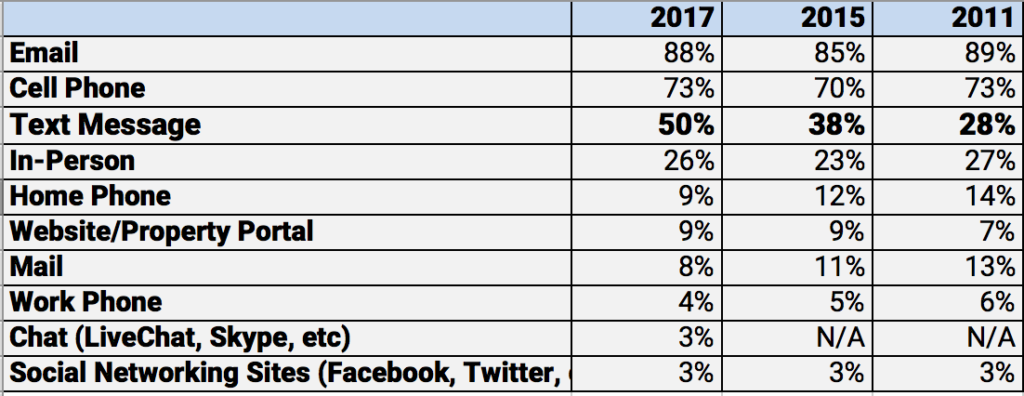

A Culture of Responsiveness
The way we communicate has changed dramatically over the past several years, and even the amount of time we’re willing to wait for information has changed. In our on-demand society, creating a culture of responsiveness has never been more important.
Based on the newly completed SatisFacts 2017 Online Renter Study, we’re entering a new era of communication preferences, and we need to be able to keep up.
If your community staff needs to communicate with you, how would you prefer they contact you?

While email and cell phone remain at #1 and #2 as the preferred method of contact, text message continues to gain momentum with no signs of slowing. According to research by Text Request, 99% of text messages are read, 90% of those within 5 minutes. In comparison, email open rates average between 13% and 30%, depending on the industry, according to 2016 Mailchimp email benchmark data.
Effectiveness and rising demand are on the side of text messaging, but unfortunately, the multifamily housing industry is lagging in its understanding of how to use this technology to its greatest advantage – the right way.
The Telephone Consumer Protection Act was updated in 2013 to address text messaging, so while residents and employees are expressing the preference to text, it’s important to have to proper standards in place. Here are some starting points to evaluate if you are using text messaging with residents legally, appropriately, and effectively.
1. Obtain specific written consent before sending texts.
Even if a resident has verbally assured the community team that they prefer to communicate via text, get it in writing. Express permission to text and the ability to opt out are key processes you need to have in place. It’s no longer enough to have a prior, established business relationship with your resident. Wanna text? Sign on the dotted line, please.
2. Implement a system that provides a secure platform for texting.
When it comes to community management, especially for those team members who live on site, it can become very challenging to create boundaries of work life and personal life. Texting makes it that much more difficult when residents ask to text the manager or asks a team member to text them some information. Contact At Once provides an excellent series of questions to drive the point home: When your associates text prospects or residents, do you have:
- A record of their written consent to be texted?
- A transcript of the text conversation?
- Control over the opt-out message?
If they’re using their personal cell phone, the answer to each of these questions is most likely, “No.” And that can have serious legal consequences, in addition to potential personal safety issues. There are software solutions available that provide a community number for residents and prospects, which allows a team member to respond or initiate texts via an app on their own handheld device. This creates security for the resident, the employee and the company.
3. Respond in two hours? Try two minutes.
For the past year and a half, we’ve been teaching that the average customer (regardless of industry) expects to receive a response to their email or voice mail within 2 hours. Texting, while easier to do, raises the bar on response time. The average text message receives a response within 90 seconds. If that’s what the average person is accustomed to, that’s what the target needs to be from a business perspective.
The culture of responsiveness just got an overhaul, and text is your new tool to rule the competition and prove to your prospects and residents that your community is the place to call “Home, sweet home.” Get the right permissions, the right platform and the right response time, and you’ll be leaps and bounds ahead of your competition.

1 Comment. Leave new
[…] to get in touch with your residents? SatisFacts 2017 Online Renter study reveals that 88 percent of respondents prefer to be contacted via email; 73 percent ask to be […]